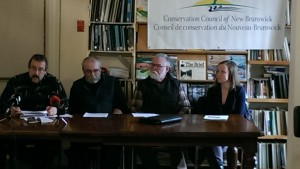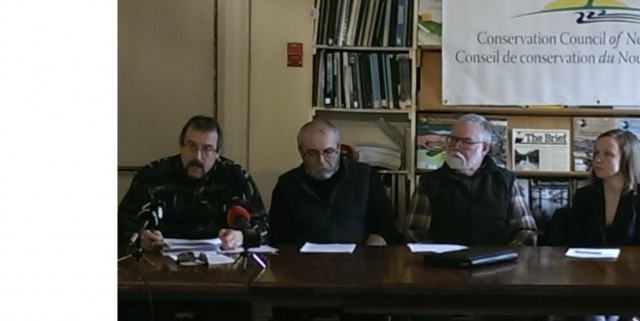 Fredericton – Biologists, hunting, fishing and outdoors recreation groups and conservationists are uniting in a call to ban herbicides in the forest by sending a letter today to New Brunswick Natural Resources Minister Paul Robichaud. The letter, which attempts to set the record straight on the impacts of using herbicides in the forest was signed by the Central NB Quality Deer Management Association, NB Wildlife Federation, NB Outfitters Association, Professional Outfitters and Guides Association, NB Chapter of the Ruffed Grouse Society, Bowhunters of NB, Big Game Club of NB and the Conservation Council of New Brunswick.
Fredericton – Biologists, hunting, fishing and outdoors recreation groups and conservationists are uniting in a call to ban herbicides in the forest by sending a letter today to New Brunswick Natural Resources Minister Paul Robichaud. The letter, which attempts to set the record straight on the impacts of using herbicides in the forest was signed by the Central NB Quality Deer Management Association, NB Wildlife Federation, NB Outfitters Association, Professional Outfitters and Guides Association, NB Chapter of the Ruffed Grouse Society, Bowhunters of NB, Big Game Club of NB and the Conservation Council of New Brunswick.
Herbicides kill broad leaf trees, shrubs and grasses destroying the food source and habitats of many forest dependent species, including deer, which concerns wildlife and deer biologist Rod Cumberland.
“Herbicide use in our forest is presented to us as the only way but it’s not. It is the most profitable means of removing competing hardwoods for a hungry forest industry. Thinning crews used to remove hardwoods in New Brunswick and that’s what they do in Quebec today. In a climate where our province is drastically struggling to keep skilled workers from moving west, we find it incredibly ironic that the government of New Brunswick refuses to entertain a method of hardwood removal that will create good paying jobs for New Brunswickers and one that does not carry with it potential health threats and biodiversity damage that herbicides cause,” says Cumberland who is concerned by the government of New Brunswick’s continued defence of herbicides on New Brunswick’s forest. He feels that there are obvious impacts with two decades of use of Monsanto’s Vision glyphosates on New Brunswick’s forest.
The forest industry and government counter the concerns of biologists, conservationists and citizens by arguing that only 1% of the forest is sprayed annually. However, 1% is actually an area of 13,000 hectares a year – or over 26,000 acres. “From a deer’s perspective, an acre of regenerating land can produce between 20,000-40,000 stems of hardwood, equalling a ton of deer food per acre. Deer consume on average 2 kg of this browse daily, so in effect, herbicide spray removes 26,000 tons of deer food a year from Crown land. And you wonder why you have vacant deer yards on Crown land?” says Cumberland. According to Cumberland’s figures, the herbicide program has removed nearly a half a billion tons of deer and moose food from the public forest in the past 20 years.
“Now that deer have been forced to private land where good deer food still grows, large forestry companies believe they have licence to clearcut the last remaining mature forests on our public land that is tied up and protected in deer yards,” says Cumberland.
The most commonly sprayed forest herbicide in New Brunswick, glyphosate, is currently under review by Health Canada. “The re-evaluation of glyphosates is the result of a large and growing number of scientific studies that show its toxic impacts in a wide range of species including humans. Given this, the Conservation Council believes that a precautionary approach to its application should be considered. The Canadian review is expected to be released this year,” says Tracy Glynn, the Conservation Council’s Forest Campaign Director.
If the plan to convert 28% of our forest to plantations goes ahead in the next 50 years, New Brunswickers will have to shell out over $600 million to the pulp and paper companies, according to Department of Natural Resources’ figures that estimate silviculture costs, which includes herbicide spraying, at $1000/hectare.
“We have to change this. We have to go back and look at the Crown Lands and Forest Act and make sure that not only the revenue for all the owners, we the people, but all that the life that lives within that Crown forest is protected for our children and our grandchildren,” says Charles Theriault who is making a documentary about forest mismanagement that resonates with New Brunswickers’ experiences. His episodes and a petition to open up the Crown Lands and Forest Act is found on his website, isourforestreallyours.com.
New Brunswick stands alone in using public dollars to pay for the chemical spraying of its public forest. Nova Scotia recently announced that they will no longer fund herbicide spraying of their forest and will reduce clearcutting to 50%. Quebec banned herbicide spraying of its public forest over a decade ago in 2001. “If this herbicide is so safe, can someone explain to me why so many agencies and jurisdictions are abandoning its use,” says Cumberland.
New Brunswick has been spraying herbicides since the 1970s when it first permitted pulp and paper companies to clearcut natural forest and replace it with plantations. Spraying usually occurs one to two years after a plantation has been established. Herbicides are sprayed once or twice over plantations to poison hardwood trees and shrubs that compete with the planted softwood trees for space and nutrients. Spraying occurs each year in August and September and lasts about 40 days.
“In 2011, 4,000 New Brunswickers signed a petition to say no to spraying our forests. The petition was the third such petition against herbicide spraying of the forest tabled in the Legislature in less than a decade. Over the years, old spruce and fir stands and beautiful maple and birch ridges have been clearcut, doused with herbicides and replaced with tree farms. We are wiping out our diverse forest but it’s not too late for us to bring back our forest, wildlife and meaningful employment in the woods,” says Glynn.
-30-
Check out this fact sheet and action alert on forest herbicides by a group of concerned New Brunswickers:

